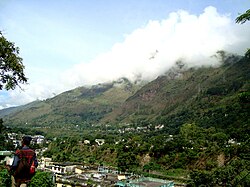Dharchula | |
|---|---|
city | |
 View of mountains from Dharchula | |
| Coordinates: 29°50′54.6″N 80°32′34.8″E / 29.848500°N 80.543000°E | |
| Country | |
| State | Uttarakhand |
| District | Pithoragarh |
| Elevation | 940 m (3,080 ft) |
| Population (2011) | |
| • Total | 7,039 |
| Languages | |
| • Official | Hindi |
| Time zone | UTC+5:30 (IST) |
| PIN | 262545[1] |
| Vehicle registration | UK |
| Website | uk |
Dharchula is a town in Pithoragarh district in the northern state of Uttarakhand, India, situated at an elevation of 940 m above sea level, surrounded by peaks from all sides and Kali river cutting through the middle, dividing the area into two towns on either bank of the river - one in India and the other in Nepal. River Kali originates from Lipulekh Pass and forms the border between India and Nepal. People of the two towns have similar traditions, culture, and lifestyle, and can move across the border without a passport or visa. The area has a mixture of Kumaouni and Rung language, traditions and culture. They move freely across the river as Indians and Nepalis do not need passport or visa to cross the soft border. Dharchula lies about 92 km (57 mi) north of Pithoragarh town, along the route of the Kailash-Mansarovar pilgrimage tour. It lies on the Pithoragagh-Lipulekh Pass Highway (PLPH).
Dharchula gets its name from ‘Darchyo’ and ‘la’; Darchyo is a white coloured traditional holy flag and la is an honorific term in Runglwo.[2] It is situated in a valley, on the banks of the Kali River.
Demographics[edit]
As of 2011, the population of Dharchula Nagar Palika (municipality) was 7,039 (3,797 males and 3,242 females), with a female sex ratio of 854 compared to the state average of 963. Children of 0–6 years represent 12.64% of the population with a child sex ratio of 824 compared to the Uttarakhand state average of 890. The literacy rate of Dharchula city is 88.68%, higher than the state average of 78.82%; literacy in males is around 95.10% and in females, it stands at 81.20%.[3]
History[edit]
Dharchula was an ancient trading town on the Trans-Himalayan trade routes. Trade was based on barter system and was the only source of income for the inhabitants of Dharchula. Local handicrafts like carpets which are known here as ‘dan’, were exchanged with the Tibetans for food and clothing.[citation needed]
After the Indo-China War in 1962, all trading ties with the Tibetans came to a stop which caused innumerable hardships to the people of Dharchula. The difficulty forced people to look for alternate means of earnings. Soon the locals engaged themselves in farming, small businesses and cattle farming. With government intervention, good tourism facilities have developed in the town.[4]
References[edit]
- ^ "Dharchula Pin code". pin-code.net. Archived from the original on 29 June 2021. Retrieved 29 June 2021.
- ^ "Dharchula".
- ^ "Dharchula Nagar Panchayat City Population Census 2011-2022 | Uttarakhand".
- ^ "Brief history of Dharchula".

